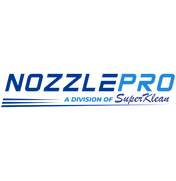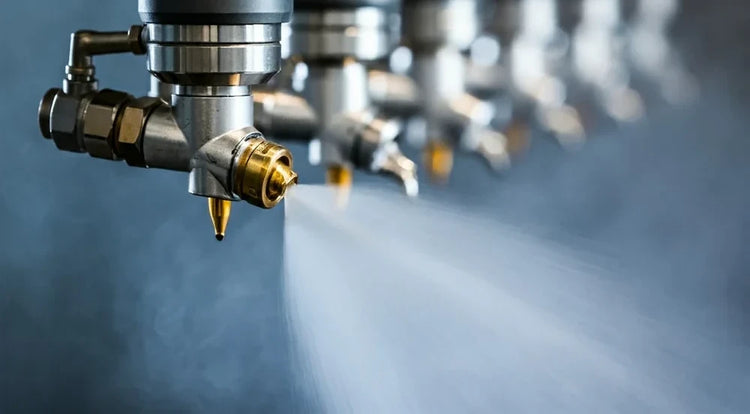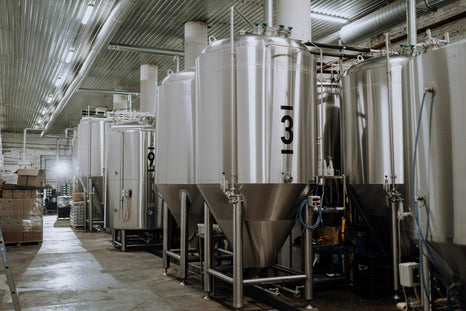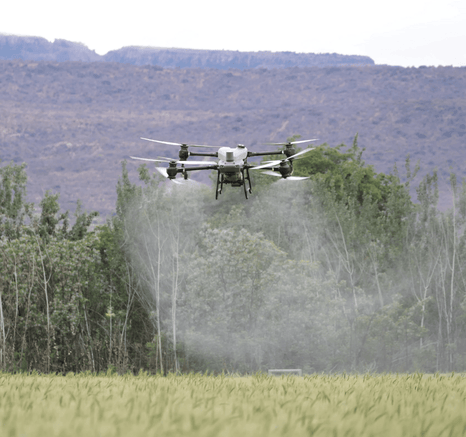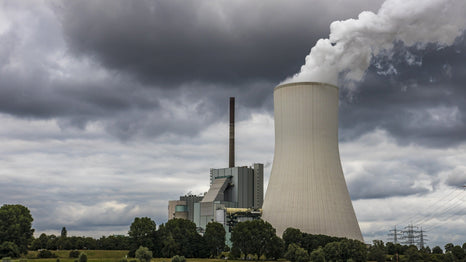Key Takeaways
-
Selecting the right high pressure nozzle requires balancing five critical variables: application goal, impact vs coverage needs, operating pressure and flow, spray angle with stand-off distance, and fluid environment
-
Pattern selection (solid stream, flat fan, full cone, or rotating head) directly impacts cleaning effectiveness, with narrower angles delivering maximum impact and wider patterns providing better coverage
-
Proper sizing involves matching your pump's pressure and flow capabilities to the correct orifice size and spray angle for your specific working distance
-
Material selection and internal design (axial vs tangential) determine nozzle longevity and clog resistance in harsh industrial environments
What "High Pressure" Means in Industrial Applications
Industrial high-pressure cleaning operates in a fundamentally different range than consumer pressure washers. While residential equipment typically maxes out around 3,000 PSI, industrial systems regularly operate between 3,000 and 40,000+ PSI for applications ranging from parts washing to paint removal and surface preparation.
A typical high-pressure system follows a simple chain: pump → hose/lance → nozzle. Each component influences the final result. The pump determines available pressure and flow. The hose and lance deliver that energy to the work surface. The nozzle converts pressure and flow into a specific spray pattern, controlling impact force, coverage area, and cleaning effectiveness.
Understanding water-jetting categories is essential. Pressure alone doesn't tell the complete story. A jet nozzle operating at 10,000 PSI with 2 GPM delivers very different results than the same pressure at 10 GPM. Flow rate determines the total energy available, while the nozzle's orifice size and spray angle control how that energy is distributed.
Safety Note: High-pressure water jets can cause severe injuries, including fluid injection injuries. Always follow lockout/tagout procedures, wear appropriate PPE, and maintain safe stand-off distances. Refer to OSHA's guidelines on high-pressure water-jetting hazards for comprehensive safety protocols.
The 5 Variables That Actually Decide the Nozzle
1. Application Goal
What are you trying to accomplish? Paint or rust removal requires high impact force concentrated in a small area. Parts washing needs thorough coverage with moderate impact. Clean-in-place (CIP) systems for tanks demand 360-degree distribution. Define your end goal before selecting any hardware.
2. Required Impact vs Coverage
This is the fundamental tradeoff in nozzle selection. Narrow jet patterns concentrate energy for maximum impact, ideal for descaling or cutting operations. Wider fan or cone patterns sacrifice some impact force but cover larger areas more efficiently.
3. Operating Pressure and Available Flow
Your pump defines the boundaries. Every pump has a pressure-flow curve showing what combinations are physically possible. A nozzle that requires 15 GPM at 5,000 PSI won't work if your pump can only deliver 10 GPM at that pressure. Always start with your pump's capabilities.
4. Spray Angle and Stand-Off Distance
Catalog specifications list spray angle measured at the nozzle tip at design pressure. Real-world coverage changes dramatically with distance. A 25-degree spray pattern might cover a 6-inch circle at 12 inches away, but gravity, air movement, and increased distance alter the actual footprint.
5. Fluid and Environment
Operating temperature, chemical compatibility, and debris content all influence nozzle selection. Hot water or chemical solutions require specific seal materials. Fluids containing particulates increase clogging risk. Corrosive environments demand stainless steel or ceramic construction.
Shortlist the Right Pattern for High-Pressure Cleaning
Solid Stream / Jet
Maximum impact force concentrated in a small area. Used for descaling, cutting, pinpoint cleaning, and heavy buildup removal. These pressure washer nozzle tips create a coherent stream that maintains velocity over longer distances.
Flat Fan
Creates a line-shaped spray pattern ideal for wash and rinse lines, conveyor cleaning, and continuous web processing. Angles typically range from 15 to 110 degrees. Overlapping multiple flat fan nozzles creates uniform coverage across wide surfaces.
Full Cone
Produces circular coverage with relatively even distribution throughout the pattern. Used for general washing, rinsing in cleaning cells, and applications requiring uniform treatment of circular or irregular surfaces.
Rotating/Tank-Cleaning Heads

Specialized nozzles for CIP applications and vessel internals. Static spray balls provide fixed pattern coverage, while rotary cleaners use jet reaction or gear-driven rotation to sweep the interior surface. Learn more about tank cleaning solutions on our specialized page.
Internal nozzle design significantly affects performance. Axial-flow designs use vanes to create rotation, producing finer droplets and precise angles but with higher clogging risk. Tangential designs inject fluid off-center without internal inserts, offering better clog resistance at the cost of slightly less precise patterns.
Pressure, Flow, and Angle: How to Size the Nozzle
Follow this systematic approach:
Step A: Fix Pressure and Target Flow
Start with your pump's specifications. Identify the operating pressure and available flow rate. This defines your working envelope.
Step B: Choose an Angle for Required Footprint
Determine your working stand-off distance. Use manufacturer coverage calculators to find what spray angle delivers your desired coverage width at that distance. Remember that catalog angles are measured at the nozzle face.
Step C: Pick Orifice Size for Flow Delivery
Consult vendor flow charts to select an orifice that delivers your required flow at your operating pressure. For instance, a 0.040-inch orifice might deliver 8 GPM at 4,000 PSI.
Step D: Validate in Real Conditions
Theoretical calculations provide a starting point, but air currents, part movement, and spray drift affect actual coverage. Conduct floor tests with your actual setup before full production implementation.

Material, Build, and Clog-Resistance
Nozzle longevity depends heavily on material selection:
Stainless Steel: Standard choice for most industrial applications, offering good corrosion resistance and reasonable wear life. Cost-effective for moderate-duty applications.
Brass: Lower cost option for light-duty applications with clean water. Not suitable for abrasive fluids or corrosive chemicals.
Carbide/Ceramic Tips: Premium materials for abrasive environments or ultra-high-pressure applications. Carbide tips can last 10-20 times longer than stainless steel when dealing with particle-laden fluids.
Seal Materials: O-rings must withstand your operating temperature and chemical exposure. Viton seals handle most industrial chemicals and temperatures to 400°F.
Filtration is critical for protecting nozzle investment. Install appropriate filters upstream based on your smallest orifice size. A general rule: filter to 50% of orifice diameter. Poor filtration leads to premature wear and pattern distortion.
Safety and Compliance Essentials
High-pressure water jets present serious hazards:
Jet Injection Risk: Even small orifices at moderate pressures can inject fluid under skin, causing severe tissue damage. Maintain proper stand-off distances (typically 12 inches minimum) and never point nozzles at people.
Personal Protective Equipment: Face shields, water-resistant clothing, and hearing protection are minimum requirements.
Lockout/Tagout: Always de-energize the system and confirm complete pressure bleed-down before changing nozzles or performing maintenance.
For surface preparation applications, refer to ISO standards for water-jet cleaning which provide specifications for cleanliness levels achieved through high-pressure water blasting.
Quick Chooser: Use-Case to Nozzle

For Heavy Descaling / Pinpoint Impact
Solid stream or narrow-angle jet nozzle; 0-15 degrees; carbide tip for longevity; 10,000+ PSI typical. View our jet nozzle collection.
Line Rinsing / Conveyor Wash
Flat fan pattern; 25-65 degree angle; overlap strategy with multiple nozzles; 1,500-3,000 PSI typical.
General Wash / Rinse in Cleaning Cells
Full cone pattern; 40-80 degree angles; focus on uniformity; 2,000-5,000 PSI typical.
Tank/CIP Applications
Rotating tank-cleaning nozzle sized to vessel diameter and available pressure; flow rate determines cycle time.
Troubleshooting and Optimization
Problem: Streaking or Uneven Coverage
Causes: Worn orifice, nozzle misalignment, or incorrect angle selection.
Fixes: Measure flow rate against specifications; verify mounting alignment; recalculate coverage for actual working distance.
Problem: Low Impact Force
Causes: Spray angle too wide, stand-off distance excessive, or pressure loss in supply lines.
Fixes: Switch to narrower angle; reduce working distance if safe; check for hose restrictions.
Problem: Frequent Clogging
Causes: Inadequate filtration, particulate in fluid, or axial design with fine passages.
Fixes: Upgrade filtration; switch to tangential internal design; implement regular inspection schedule.
Problem: Uneven Cone Pattern
Causes: Physical damage to orifice, wear on one side, or internal deposits.
Fixes: Inspect under magnification; replace if damage is visible; implement maintenance tracking. Track flow rate against specifications monthly in critical applications. A 10% flow increase at constant pressure indicates significant wear requiring nozzle replacement.
Buyer's Checklist
Use this checklist to ensure complete specification:
-
[ ] Application type and surface material
-
[ ] Target cleaning outcome and required cleanliness level
-
[ ] Available pump pressure (PSI) and flow rate (GPM)
-
[ ] Working stand-off distance from nozzle to surface
-
[ ] Required spray angle and coverage width
-
[ ] Calculated orifice size for pressure/flow match
-
[ ] Material selection (body and tip)
-
[ ] Filtration requirements
-
[ ] Safety equipment and procedures
-
[ ] Proof-run validation plan
Ready to specify your system? Send your completed checklist to NozzlePro engineers and we'll recommend the exact nozzle configuration for your application.
FAQs
Q: What spray angle gives the best balance between impact and coverage?
A: There's no universal answer since it depends on your specific application. Narrower angles (0-25 degrees) maximize impact force for tough removal jobs but require more passes for area coverage. Wider angles (40-80 degrees) cover more area per pass but with reduced impact. Use coverage calculators to determine what angle delivers your required footprint at your working distance, then test to verify effectiveness. Most industrial cleaning falls in the 15-40 degree range.
Q: Why doesn't the catalog spray angle match my floor test results?
A: Catalog angles are measured at the nozzle orifice face at design pressure under controlled conditions. Real-world coverage expands with distance due to spray geometry, and gravity pulls droplets downward. Air currents and part movement further alter actual coverage. Always add 20-30% margin to theoretical calculations and conduct validation tests at your actual working distance.
Q: When should I choose axial vs tangential internal design?
A: Axial designs with internal vanes create more precise spray patterns with finer droplet control, ideal for applications requiring uniform coating. Choose axial when fluid is clean and pattern precision is critical. Tangential designs without internal inserts offer superior clog resistance. Choose tangential for dirty fluids, high-particulate environments, or applications where maintenance access is limited.
Q: How often should I replace high pressure nozzles in continuous operation?
A: Replacement intervals depend on operating pressure, fluid abrasiveness, and material selection. In clean water systems with stainless steel nozzles, expect 1,000-3,000 hours of operation. Abrasive fluids can reduce this to 200-500 hours. Carbide tips last 5-10 times longer than stainless steel. Track flow rate monthly; when flow increases 10-15% at constant pressure, the orifice has worn enough to affect performance.
Q: Can I use the same nozzle at different pressures than specified?
A: You can operate a nozzle across a range of pressures, but performance characteristics change. Spray angle tends to narrow at higher pressures and widen at lower pressures. Flow rate follows the square root of pressure: doubling pressure increases flow by only 41%. Droplet size and impact force also change with pressure. For best results, select nozzles designed for your typical operating pressure.
